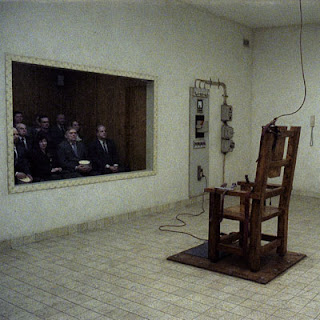Goethe
What is it, then, to be the living? Is it about to love, being loved, or about breathing? Or is it the joy of another human being?
The 2007 Swedish black comedy Du Levande tells the story - well, not much of a conventional one - of the glory of existence centered around a bunch of ordinary people, with the repetition of appearance of especially a broken-hearted groupie, a psychiatrist with years of disappointment by his patient's selfishness, an overweight woman and a businessman. It is hard to say that there exists a central plot, however, some of the stories connect to each other though somewhat loosely. There are various concepts that are used repeatedly throughout the movie, such as dreams or music. Among the 50 little stories in the movie, most notable - for me - are;
(1) A carpenter's dream where he is sentenced to death by electric chair, only because he broke a 200-years-old china set while trying to make a tablecloth trick.
(2) A girl bumps into her music idol in a local bar eventually sharing a few drinks, however, she gets false signals from the musician and her heart is broken, leading to a dream in which she marries him with people around cheering for them.
(3) An overweight woman repeatedly expresses her suffering from existence, that noone likes her etc, while being totally self-absorbed. Her overweight boyfriend tries to comfort her everytime but she keeps pushing him away, eventually, at the end of each little capture, agreeing to join him.
(4) A businessman gets his hair kind of butchered by a sad barber, right before an important business meeting with a CEO, and yet, the CEO dies of a heart attack at the most crucial point of the meeting.



Du Levande by the brilliant director Roy Andersson is a surprisingly heartwarming movie with characters that look ordinary and yet that are somewhat at the same time quite extraordinary. Their stories look like the themes of everyday life but they lead to a greater look on humanity. One of the most interesting facts about the production is that all the cast is amateurs and all the scenes except one had been shot in one take. Another important characteristic of the film is the use of the colours; not without much of a contrast, creating a calming and somehow more intense ambience. In the director's own words;
"I want to have a so-called monochrome colour scape. Monochrome; not too strong colours and not too strong a contrast because that is irritating to me. There is more intensity, in my opinion, when you create a picture with not too much contrast concerning colours and even contrasts. I want light that has not much shadow because I want light where people can’t hide in – light without mercy."

It is hard to believe that the glory of life and existence can be expressed by such mostly selfish and hardly satisfied or happy characters, and yet, the best explanation roots from the Norse proverb taken from Hávamál in the Poetic Edda;
I was once young,
I was journeying alone,
and lost my way;
rich I thought myself,
when I met another.
Man is the joy of man.




No comments:
Post a Comment